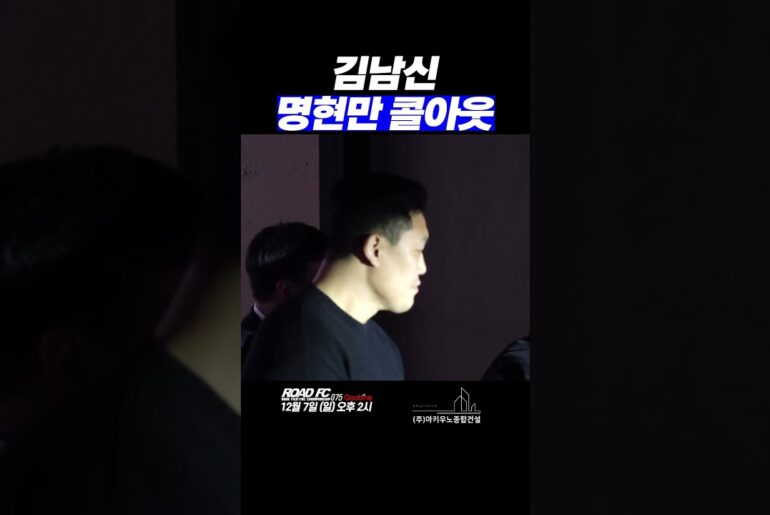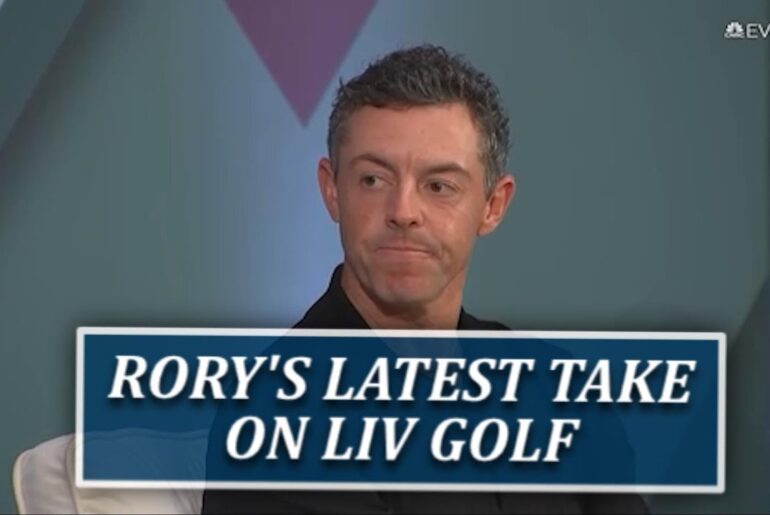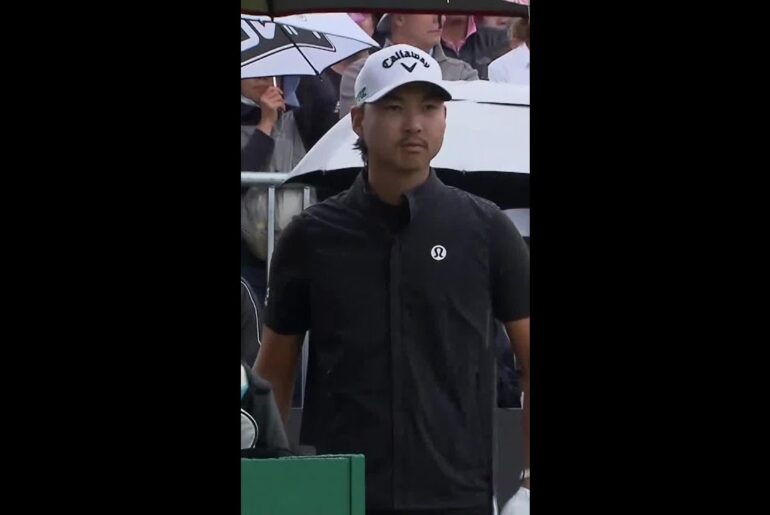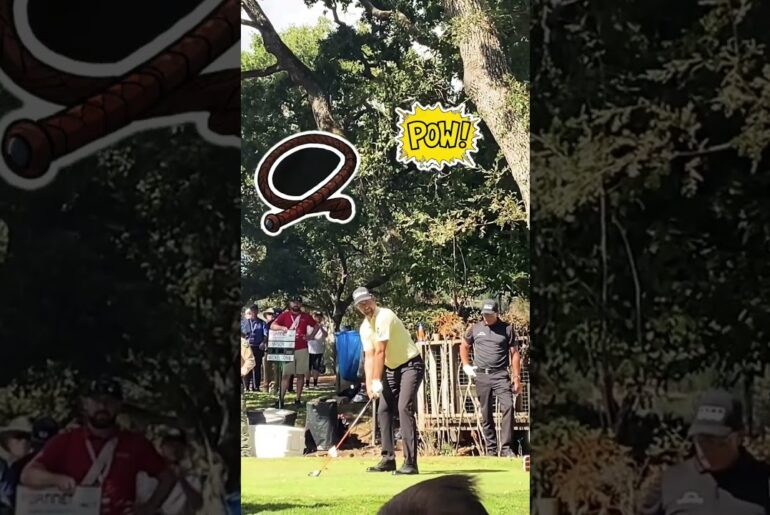Take a journey through Augusta National as we deep dive into each hole at this storied course ahead of the Masters. The best part? These descriptions are 65 years old! GOLF’s Dylan Dethier revisits Bobby Jones’ words from the 1959 Masters Preview issue of Sports Illustrated.
—–
At GOLF.com, we’re here to help you live well, play well. From the Top 100 Courses in the World to the Top 100 Teachers in America, we connect you with the places and people that make golf the greatest game in the world. Our personalities provide exclusive access to Tour pros, celebrities, and golf’s colorful characters. Subscribe to our YouTube channel, visit GOLF.com, and follow us for the latest Tour news, interviews, gear reviews, and features you won’t find anywhere else.
Subscribe: https://www.youtube.com/golf_com
—–
Instagram: https://www.instagram.com/golf_com/
Twitter: https://twitter.com/GOLF_com
Facebook: https://www.facebook.com/golf
TikTok: https://www.tiktok.com/@golf_com
0:00 Bobby Jones
1:17 Hole 1
2:29 Hole 2
4:06 Hole 3
5:00 Hole 4
5:53 Hole 5
7:14 Hole 6
8:24 Hole 7
9:12 Hole 8
10:10 Hole 9
10:52 Hole 10
12:42 Hole 11
14:19 Hole 12
15:29 Hole 13
17:06 Hole 14
17:55 Hole 15
20:04 Hole 16
21:52 Hole 17
23:30 Closing Thoughts
24:14 Hole 18
so in prepping for this year’s Masters we dug up an old issue of Sports Illustrated with Bobby Jones on the cover and there’s some there’s some good stuff in here there’s Arnold Palmer there’s Tommy armor in here there’s a lot of lot of golf in this Sports Illustrated but there’s this really cool thing where Bobby Jones runs through whole by hole how he sees Augusta National and Bobby Jones was the the golfing mind behind the course behind the project one of the guys that brought in Alistar McKenzie to begin with I think when we think about Augusta and we think about the Masters we think about how many things have changed how many different ways the course has been tweaked and tucked and how if they need a new golf hole they can just buy the hole from the course next door and expand into that if a tree falls like it did that the Masters last year then by the next morning you’ll never know it was there but there are these enduring Concepts these strategic Concepts these values that Bobby Jones certainly was focused on in the ‘ 50s that ring true today so this isn’t the fastest paced video that we’ve ever made on this channel but I wanted to read through a bunch of the whole descriptions and just show how yeah a bunch of things have changed but a lot more haven’t hope you enjoy I’ll pop back in throughout the video to point out a couple selections that I think are particularly interesting starting at hole number one 400 yards par 4 this hole can be played straight away from TD green although the the Fairway does expand on the right as it approaches the green ordinarily the Fairway bunker on the right presents no problem for the tournament player with a heavy wind against however as often happens a half hit t- shot may catch this bunker at the same time a drive down the right side of the Fairway is only important when the wind is behind and the hole is cut immediately behind the bunker at the left front of the green under these circumstances the drive down the right side makes it possible to play more nearly for the pin with the second shot the player who drives down the left side must play as second shot either over the bunker or into slopes which tend to direct his ball off the right side of the green a sort of shelf across the back of the green offers several interesting pin locations especially when the wind is against with the flag placed far back a player will think things over very carefully before he goes boldly for the PIN for fear of going over the backside but with a cautious shot to the green he often leaves himself an extremely difficult approach putt from the lower level of the green number two 555 yds par five although this is the longest hole of the course a well hit t-shot will take a good run down the Fairway as it slopes over the hill it was one of our guiding principles in building the Augusta National that even our par five should be reachable by two excellent shots the possibility of using the Downs slope off the t-shot brings this long hole into this category the Contours of the Fairway and the Mounds at the top of the hill were constructed for the very purpose of aiding the player to make use of the slope in order to gain life length but to do so he must drive accurately across the big bunker if he should wander slightly to the right the opposite side of the mound will turn his ball down the right side of the Fairway and so increase the length of the hole a drive too close to the corner is likely to kick into a most unpleasant place after a fine t- shot a second played over or just past the bunker at the right front of the green May finish quite near the hole if it is placed on that side with the flag located behind the left- hand bunker the second shot if played for the green should be aimed for the center of the putting surface with the hope of getting down in two putts for a birdie four all right so number two he highlights something interesting here which is that the par fives at Augusta National were always intended to be reachable in two shots I mean I think that when we talk about oh is the golf ball going too far are these holes becoming obsolete I mean that’s a fair discussion to be had but the idea that oh these were never reachable in the old days that wasn’t true they were always designed to be two good shots should get you down around the green Eagles should be in play uh that’s part of the excitement of Augusta number three 355 Ys par 4 the aim here should be slightly right of the center of the Fairway onto The High Ground which gives good visibility of the green and also provides the best angle of an approach to any flag location a t-shot pulled to the left side of the Fairway is very likely to follow the run of the ground and roll right on into the big bunker the green on the left is very shallow on the right side it is very deep but it slopes away from the player so that it’s not easy to be certain of the exact location of the flag the main problem presented by the second shot which is normally played with a wedge or eight iron is to gauge the distance precisely with the pin on the left side a second shot played either short or over leaves a very difficult pitch to be made and this almost always results in the loss of one stroke of and two with the win behind him the wise player will play for the center of the green hoping to get down in two putts for a par 4 number four 220 y Par 3 the length of this hole can be varied a great deal depending upon use of the back te or the rear portion of the forward tea from the back tea the shot is usually a strong iron or even a four or three wood at tournament time in April there is very often a heavy wind on this hole blowing directly against the player or quartering off the right with the pin located immediately behind the bunker in front of the putting surface or on The High Ground at the back of the green a very precise Judgment of distance is required to avoid either a long and difficult approach putt or an exacting chip the green is so large that a shot played to the outer reaches more often than not will result in a bogey four the back te is somewhat elevated so that the shot is exposed to the violence of any wind which may be blowing at the time on some days the wind will place many players in the leftand bunker or Beyond Bobby Jones is obsessed with angles and not just aiming to a specific side of the Fairway but if you take take on trouble you will be rewarded with a better angle maybe a flatter lie in the Fairway and a shorter distance to the green so on number one on number two and on number five for sure the lines that you take off the te the the risk that you take on that’s going to affect your shot into the green number five 450 yards par 4 the proper line here is as closely as possible past the bunker on the left side of the Fairway it is not not necessary to carry this bunker in order to direct the drive into a Groove in the Fairway on top of the hill but it is a very comforting safety factor to have sufficient length for the carry should the shot be pulled slightly the bunker and the woods to the left of it usually represent dire disaster for those unlucky enough to end here players lacking the necessary confidence to play along the dangerous left side sometimes become over cautious and play too closely down the right side of the Fairway from this side the second shot to the green becomes much longer and far more difficult on this hole with the green surface in proper condition the second shot must be dropped short and allowed to run up the bunker in back of the green was placed there not for penalty but simply as an effort to help minimize the damage caused by an overplayed second shot number six 190 y par three the really difficult pin area on this particular green is formed by the plateau located at the right back corner in order to land upon and hold this Plateau the shot must be very accurately struck with the ball stopping either short of this raised area or off to the left of it it is an extremely difficult job to get the first putt close to the hole the front of the green immediately behind the bunker is the easiest location back of this the side slope is severe this is one of the easiest tolls on the course but the setting of The Big Green is very lovely when viewed from the elevated te this area comprising the sixth hole and the spectacular 16th is one of the most popular spectator spots it’s interesting to me that he highlights on number six the Sunday pin on the back right shelf but also The Spectator area one of the coolest places to watch the masters from is that hill on the sixth the par 3 Sixth and you can look over at the sixth green and you can also look across the pond at the 16th green it’s one of the best places to be especially early in the week on a nice sunny day but it’s cool to know that that was the case even back in the ‘ 50s number seven 365 yard par 4 the t- shot on this hole becomes tighter year by year as the pine trees on either side of the Fairway continue to spread length is certainly not at a premium here but the narrow Fairway seems to have an added impact because it suddenly confronts the player just when he has become accustomed to the broad expanses of the preceding holes actually the second shot is somewhat easier if it can be struck firmly so that the needed backspin may be obtained the green is quite wide but also very shallow the second shot is normally a steep pitch often with a wedge and precise Judgment of range is required we are aware of our responsibility for keeping this Fairway in the best possible condition so the players will uniformly encounter good lies from which they may be expected to produce controlled shots number eight 530 yards par five this is another par five which can be reached under normal conditions with two fine shots here again although the line is not directly over the bunker It is Well to hit the t-shot with sufficient power to make the carry it is important that the ball be kept a bit to the right of the center of the Fairway so that the second shot may be played through the saddle formed by the Mounds at the top of the hill and so directly towards the green should he play left to avoid the Fairway bunker the player must risk skirting the trees on the left in his second shot in order to get very near the green many good rounds have been spoiled by encounters with the trees at this point and a second played out safely to the right usually leaves a very difficult approach it is an indication of our interest in our spectators at Augusta that that this screen was completely redesigned and rebuilt for the sole purpose of providing better visibility for spectators and a better Gallery flow through what had been a congested area number nine 420 yards Par Four this is a slight dog leg to the left which invites the player to skirt the trees on the left side actually this is a delusion because it is only with a strong wind against that this line has any advantage the player is thus called upon to make make use of local knowledge and resist the temptation to play close to the corner simply because of the dog leg under normal playing conditions a long drive straight down the middle of the Fairway will give the best results since the ball will reach a reasonably flat area and provide an open shot for at least half the green the hole opens up more and more as the drive is played to the right but the distance becomes increasingly longer number 10 470 Ys par 4 this to my mind is one of the most beautiful holes I have ever seen especially at tournament time when the Dogwood and red bud are in bloom the tea is on high ground and I might add immediately in front of my cabin the Fairway goes down in a broad slope from the tea following on the left a straight line to the green but on the right Fanning out to a considerable width on the right side the Fairway continues in the same general slope to the bottom of the hill just short of the green but on the left at about 230 yards from the te the slope runs off abruptly into a valley of Fairway some 30 or 40 yards wide since the hole is of good length for a par 4 it is decidedly advantageous for the player to make use of the Run offered by this slope therefore the line of play is down the left side as close as one may dare a t-shot play to the right which does not Avail itself of the slope will add at least two club numbers to the length of the second shot in addition to which the approach to the green must be made across the slopes rather than directly into them a good drive down the left side usually makes it possible to play the second with a medium iron sometimes even less if the wind is behind the green Nestles on a Hillside and is framed by some giant Pines which give the impression of Gothic spires when the Dogwood is In Bloom the impression of a recent snowstorm adds great Beauty to the appearance of the entire ho number 10 I guess sat right outside Bobby Jones’s cabin um so it held a special place in his heart but it’s also a beautiful hole and the way he describes it makes me think that this wasn’t just a pro the thought about how to score the lowest on a hole this is a guy that was thinking about golf courses the way you might think about architecture the way you might think about a great big building and uh his description of number 10 definitely Taps into that number 11 445 yards par 4 the t-shot to this hole is blind and that the Fairway upon which the ball is to land is not visible from the tea nevertheless the limits of the Fairway are sufficiently welldefined by the trees on either side a drive down the left side of the Fairway provides better visibility of the green but slightly to right of Center is better should the pin be located on the Promontory of the green extending into the water hazard on the left the pin location on this projection of the green is often reserved for the final round a second shot played into the water here must be dropped on the near bank with water still intervening between the player and the hole with the pin located at any place on the green other than the left hand projection the hole appears simple yet it has a puzzling difficulty should the pin be at the back of the green the player tends to let up on his second shot for fear of the severe penalty involved in overplaying often he leaves himself an approach putt of more length than he would like with the pin on the forward area of the green a shot underplayed May bound to the left and come dangerously close to the water a great many players play this hole safely to the right relying on getting a long putt or chip dead for the par number 11 it’s been lengthened but but what has always been true is that this is such a terrifying second shot that guys will hit their second shots out to the right and then depending on how far you bail out you have a really difficult up and down for your par that was true in the 50s that’s true today his description hammers that home number 12 155 yards part three the Championship location for the pin here is in the shallow area of the green on the right here the distance must be gauged very accurately and the wind sweeping down along Ray Creek is often deceptive to the player standing on the te about to hit the inclination here is to be well up or at least to favor the left side where the green is somewhat wider to play safely to the left is simple but the putting problem which results is not an easy one pin locations on the left side of the green can be made testing only by pushing them far forward or far back once the t-shot has been played into the creek the short pitch to the shallow green green is terrifying indeed the lore around number 12 around this famous little Par 3 has not changed that much over the years the way he talks about the mysterious winds sweeping off of Ray Creek I mean that’s still the entire Intrigue of the master so this is a cool corner to get to and the other part that he mentions is the drop if you hit it in the water and you take your drop then you have a terrifying shot left Jordan spe can attest to that number 13 475 yards par five we call 13 a par five because under certain conditions of wind and ground few players will risk trying for the green with a second shot in my opinion this 13th hole is one of the finest holes for competitive play I have ever seen the player is first tempted to DARE the creek on his t-shot by playing in close to the corner because if he attains this position he has not only shortened the hole but obtained a more level livee for his second shot driving out to the the right not only increases the length of the hole but encounters an annoying s Hill lie whatever position may be reached with the t-shot the second shot as well entails a momentous decision whether or not to try for the green with the pin far back on the right under normal weather conditions this is a very good Eagle hole because the Contours of the green tend to run the second shot close the danger is that the ball will follow the creek and the most difficult pin locations are along this Creek in the forward part of the green several tournaments have been won or loss here even though the decision may not have been obvious at the time number 13 is probably one of golf fans favorite holes to watch it’s one of the most talked about par fivs on Earth the way it’s changed and the way people think maybe it should change but anyway from the start it was one of Bobby Jones’s favorites and you can hear from his description how he thinks it should be played but it was always meant to be reached it was always meant uh he calls it a momentous DEC decision of whether to go for that green and two and uh the rewards that could await you if you [Music] do number 14 420 yards par 4 the most popular line off the te is slightly to left of center to gain the crest of the hill and not risk the runoff of the Fairway to the right a slight deviation to left of this line often encounters the upper branches of the group of pine trees on this side a drive straying off to the right leaves the player on Lower ground from which his ability to see the left side of the green is completely obstructed by a large mound in the middle of the Fairway the green is quite large and has many interesting and difficult Contours a mound in back protects against overrunning the left side but no such buffer exists on the right the putting surface along the front spills over the Contours into the Fairway but an approach putt from this area is exceedingly difficult a really good second shot leaving the ball close to the hole is most comforting here number 15 520 yards par five the Fairway of this hole is quite wide the short rough on the left is far removed from the line of play and there is no demarcation on the right between the Fairway of the 15th and that of the 17th the t-shot may be hit almost anywhere with safety it is nevertheless of considerable importance that the line of play be along the crest of the Hill a little to the right of the center of the Fairway this Fairway being on High Ground usually provides more run to the ball than most other holes of the course it is also more exposed to the effect of any wind which may be present two T’s front and back are provided so that the length may be adjusted within wide limits according to playing conditions the design of the green causes it to be most receptive to a second shot played from the right center of the Fairway the greater depth of the putting surface is on the right side the left side is quite shallow considering the length of the second shot and the most severe hazards lie here a ball played over the green on this side may very well run down into the pond at the 16th hole It’s usually the better part of wisdom to play the second for the main body of the green even though the hole may be cut on the left side under almost any conceivable conditions the second shot to this hole suggests precarious possibilities With the Wind against the player must decide whether his power and the state of his game warrant an effort to reach with a following wind he may have to consider whether he will be able to hold the green even though it be well within reach Billy Joe Patton’s magnificent bid to be the first amateur to win The Masters ended when he tried to reach the screen from the rough on the left the ball finished in the pond the resulting six was one too many had he played safely for a five he would have tied with Sneed and Hogan the second shot at number 15 Bobby Jones talks about the precarious possibilities that await and the the possibility that you could send it over the green and down into the water at number 16 like Hideki matama did when he was hanging on to his lead again things that we have seen in recent years that were still the case in the ‘ 50s number 16 190 yards par three the t-shot to this hole will be played by the tournament Players with a number two three or four iron depending upon the wind the pond extends from the front of the tea very nearly to the edge of the green The Contours of the green are such that several pin locations can be found along the left side close to the bunkers in the pond this is also the low side so that it shot played for the middle of the putting surface but with a slight draw can be made to curl down toward the hole this of course involves a risk that the draw may be overdone Landing its perpetrator in the sand or water pin locations on the right side may vary from an acceptable one in the v-shaped front of the green through a crown about halfway back from which the ball may be expected to fall off to the left back to a gently Gathering area at the rear with the pin on this side the threats come from the bunkers on the right and the runoff of the green toward the left apart from the visible hazards on this hole the player who leaves his ball in the forward area of the green with the pin near the back can have quite a problem getting down in the two regulation putts three putts on this screen sealed Hogan’s defeat by sne in their 1954 playoff all right number 16 this is where it really gets jarring one thing that that is similar is the way he talks about yeah you can hit a draw that curls into the middle of the putting surface and can get down near the hole but the fact that he says this could be a two a three or a four iron this is an eight iron now there are certain ways that the golf course plays the same now as then but one thing that has changed I mean back in the day maybe a four or five iron was considered a mid iron now it’s pretty rare to hit one of those into a par three that’s uh you know 170 180 yards guys are not hitting two three or four iron into number 16 17 400 yards Par Four the pine tree and the Fairway way although it is only a little more than 100 yards from the tea has grown to such proportions that it provides a real menace to the t- shot the proper line of play is to the right of this tree but also to the left of the big mounds and two other trees at the top of the hill depending upon the wind a fine Drive may leave a second shot requiring anything from a good five iron or easy four to a short pitch to become involved with the Mounds on the right May impose difficulties on either lie or visibility or both on the left side the the green slopes gently but quite perceptibly from front to back with a following wind therefore even the shortest pitch over the bunker and the slopes off the base of the mound must be played quite accurately a ball played too strongly to this side of the green may take a good run off a slope at the back and so leave a difficult return chip on the right side immediately behind the bunker there is a nice little Basin which provides a most inviting place for the pin on quiet days on this side the green slopes very definitely upward toward a sort of plateau area near the back this is a very difficult pin location when the wind is against because a shot played boldly to get near the hole could go over the green down a slope whereas the safe shot may call for some difficult putts the hole looks innocuous enough yet it provided the decisive moments in the 1956 tournament when Jack Burke in a stretch run against Ken ventu and Carrie moff scored a birdie three at the hole while Venturi took five and middleof six Burke won by one stroke over Venturi and two over middleof all right I’ll let Bobby bring you up number 18 uh and thanks for watching but I’ll just leave you with this Augusta looks similar now to the way it looked in the 50s to the way it looked in the 30s to the way it looked even before then and that’s because before it was a Golf Course Augusta was Fruitland nurseries and apparently one of the reasons that developers thought it looked so good for golf is that some of these corridors were already cleared the way the nursery was set up the way it was developed some of these things already kind of looked like Fairways so maybe it was kind of always meant to be and uh Bobby and Alis and Clifford Roberts and just kind of uncovered what was destined to be a great golf course so hope you like watching enjoy the Masters here’s the 18th number 18 420 yards part 4 this hole is a slight dog leg to the right the bend in the Fairway coming at the top of a hill which can be just about carried by a fine t- shot the bunker at the left front of the green makes it a matter of some importance to drive as close as possible to the trees lining the right side of the Fairway or even if possible to bend the t-shot a bit around the corner the front area of this screen is nicely molded to receive a pitch and provide a good putt for a birdie when the hole is cut here get a ball driven to the left side of the Fairway safely away from the trees must be pitched quite closely over the guarding bunker behind this friendly area the putting surface slopes upward to the middle of the green a second shot played up this slope even a dozen feet past the hole calls for a delicate approach Putt and can very easily result in three putts it was from just such a position that Ben Hogan three putted to lose by one stroke to Herman Kaiser in 1946 in 1958 both Doug Ford and Fred Hawkins tried and missed similar putts to Tai Arnold Palmer this 18th green is quite long the rear one quarter of the putting surface Embraces a plateau area which is often used as a pin location the great difficulty here is to be up without going over a second shot played into the slope in the middle of the green either stops or rolls back so that the ensuing putt is difficult indeed in the 1957 tournament Doug Ford avoided all these putting difficulties by pulling a full blast from the bunker in front of the green to help give him his final winning margin of three Strokes








29 Comments
Great vid, crushing the content game!
I would like to get a copy of that sports, illustrated, for my Golf collection, what was the date of this issue? Thanks. Love the video.
Interesting video, unfortunately given the title, the information provided in this video is not accurate. The original design from the 1930's is far different than what you have described. Most of information provided is after many changes have been made 20+ years later. I would suggest renaming the video.
Fascinating and educational.
They raised cows on it during ww2
Suggestion with regard to the mocked-up visuals, wherein the two-dimensional hole is laid out visually: 1) Orient the drawing 'up', or 'north', as one might study a map, and 2) draw the tee-box(s) first, then a line (s) down the fairway to the green, and then 2b) fill in the bunkers and tree-lines.
Tada.
Hole #11: I realize that it is now 2024, but 1994 wasn't that long ago, and this hole was totally re-routed in ?1999ish?
With Spring comes The Masters. When we see Augusta National in all it's glory on the television every April it celebrates the of the end of winter and the start of the golf season. What an amazing place.
It would have been perfect to have the Masters not need to change holes over time. Honestly, the best idea would have been to make it a classic tournament from the standpoint that wooden headed drivers, fairways, hybrids were mandatory and no graphite shafts or cavity irons. That the tournament remained a time capsule going back to when Jones played the game. It would have kept the artistry of ball striking.
Great content!
You act like Jones designed Agusta. When it was McKenzie.
Incredible stuff 👏🏼
Well done video. It was interesting hearing Bobby’s insights along with the old photos and hole drawings.
Augusta National is a racist golf club that needs to be shut down. The caddy have to wear white robes. Just need the hoods.
Respectfully done. The 275 fairway markers in the drawings are so vintage. The Masters pressure is what brings the difficulties. Masters Week!!
Excellent video, very insightful
I enjoyed this – good job, but there is one special aspect of The Masters to which I wish all these broadcasts would give more attention. That is the names of the holes. It's such a unique part of Augusta's heritage and it is all but overlooked.
Nice video and well done.
Great production. Outstanding pace to this video. Thank you for putting something intelligent on YouTube.
Great find. Thanks!
Well Done !
A great video about Augusta National but a sad reminder of how far Sports Illustrated has fallen.
Hmmm
😰🤩😃😃😃😃😃😳😶🌫️😶🌫️
I love the 5 🕳️
Blazer alone at home?
The way most pro golfers play the holes today is different than what the original layout was designed for with the length of their shots is so much further.
Great video I’ve been watching the masters for years high definition TV brings in the undulation of the course a little more but TV still does not do that course justice great article thanks for Bobby Jones is inside on each hall
Bobby Jones would not recognize the current design.
The main reason guys aren’t hitting 4 irons 170 yards anymore is because they literally put a different number on the 4 irons these days! It’s all about loft, and the manufacturers gimmicked up the clubs so much that they had to create a new club, the “gap” wedge that they needed for the gap they created! Although I’m sure other technology has increased distance somewhat, all things being equal.